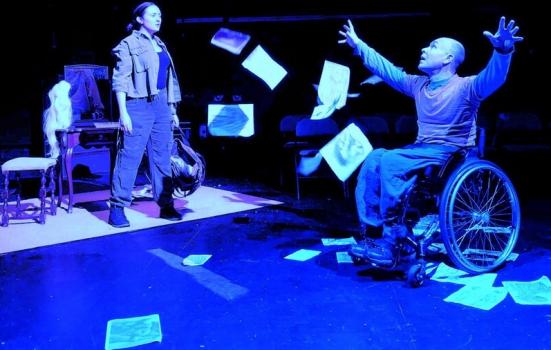Age-old paternalistic attitudes will persist unless disabled people lead change themselves, says Vici Wreford-Sinnott.

Black Robin
The radical change forced on the arts sector by the coronavirus crisis gives us the chance to reflect on how well it is addressing its stated priorities such as diversity. Many disabled practitioners were not at all surprised by Arts Council England’s (ACE) most recent disappointing data on workforce diversity. While ACE has proposed to cut funding if venues and organisations don't do better, many of us are wondering what this will mean in reality and what it will actually achieve.
It would be wrong to say that absolutely nothing has changed in the five decades we have had a disabled civil rights movement in this country. The self-organised activism of disabled people, including many disabled artists, has led to some improvements in accessibility for audiences. We now regularly see British Sign Language interpretation, relaxed spaces, subtitles, audio-description and guided accessible tours of exhibitions.
To truthfully reflect our modern society, we have to make space for previously silenced voices
But access is far from consistent across the arts, and many barriers remain. For disabled artists trying to find accessible routes to making and professionally sharing our work publicly, an age-old paternalistic model still reigns.
Attitudinal barriers
The place of disabled people in the arts – as artists, managers, leaders, colleagues and partners – is not advancing at anything like an acceptable rate. The biggest barriers we experience are nothing to do with us but come from the disabling elements of the physical, sensory, neurotypical and psychological environment. The biggest of all are attitudinal. What people think and how they behave – especially people with power in venues, organisations and institutions.
There is a fundamental systemic bias in the way mainstream decision makers and venues think about disability and equality. Culturally, we have been othering anyone considered ‘diverse’ as an outsider. It’s as if there’s a ‘normal’ group and, on its far-flung fringes, tiny groups of people of ‘difference’ – hanging onto tailcoats, trying to be heard and included.
Disabled people are consistently infantilised in the arts. Disability has been presented culturally in tragic and deficit terms for at least two millennia. These lazy stereotypes and well-trodden tropes have been continually trotted out in theatres, galleries, cinemas and museums. No wonder there is misunderstanding around disability.
Afraid to speak out
There have been initiatives over the years where disabled people, grateful for the crumbs, have become lab rats for mainstream experiments. We are given a taste of what could be possible on initiative after initiative, with no tangible outcomes. We are sometimes notionally consulted – usually with loaded questions – in ways that don’t let our true voices come through. And there are diluted challenges to the canon of representation in mainstream culture. But it often feels that we're reinventing the wheel every few years as staff move on from organisations and everything is lost.
There is a whole body of vibrant work from an artistic movement where much aesthetic, political, social and cultural progress has been made. But the discussion around the work of disabled artists is often jaw-droppingly inappropriate. We need to ensure that new pieces of work by disabled artists are not exploitative, or presented so out of context that they become part of the problem.
However, many disabled artists daren't speak out in case it jeopardises funding, careers and future work. They’re afraid of being tarred with a brush that others them and portrays them as difficult to work with. I've been hearing this for almost 30 years. It's not new, but it is exhausting and demoralising.
And we now face renewed cries of complaint that we have any measures in place around diversity at all – claims of ‘lefty wokeness’ echo the complaints of ‘political correctness gone mad’ of an earlier era. Art should be for everyone – particularly those who have been systematically excluded for hundreds of years.
Revolutionary change
To truthfully reflect our modern society, we have to make space for previously silenced voices. And many disabled people in the arts are doing their best to bring this about. There are pioneers, trail-blazers and revolutionaries, working away doggedly, making works of art while simultaneously being activists for change. They are showcasing the work of amazing disabled artists and finding effective long-term solutions.
ARC Stockton, where my theatre company Little Cog is based, is a brilliant example of a proactive ally. We have built a partnership with disabled-led practice at its heart through the strategic project Cultural Shift. We first built mutual trust by putting in the time in to get to know what was important to each party. The measures we then adopted included delivering disability equality training across the organisation and building a common language that put respect, equality and art were at the centre of the initiative. ARC has now embedded disability equality ethos and practice into its artistic policy. It is highly regarded by disabled professionals across the country and recently received an ‘outstanding’ rating from ACE for its approach.
Long-term partnerships like this can bring about real change: creating new work that challenges stereotypes, delivering impactful participatory activities, and supporting and programming work by disabled artists. The experience, vision and activism of disabled artists is now helping bring about a renaissance in disability arts across North East England. This can be seen in initiatives like Disconsortia, a consortium of 20 disabled artists.
In the current climate, it’s not hard to imagine a situation where disabled artists become invisible again – or worse, erased. But we can also see this situation as an opportunity to act decisively. It's time to hand control over to disabled people: to bring us in, listen to us and let us lead change.
Vici Wreford-Sinnott is Artistic Director of Little Cog and a freelance writer and director.
![]() viciwreford-sinnott.com | littlecog.co.uk
viciwreford-sinnott.com | littlecog.co.uk
![]() @viciws | @littlecog1
@viciws | @littlecog1





Comments
jeremyholloway replied on Permalink
Attitudinal problems....